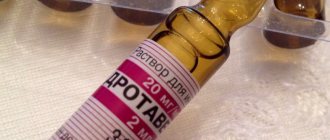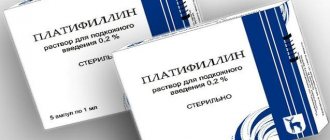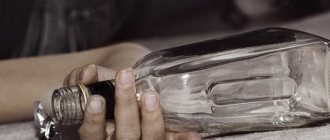Drotaverine (Drotaverine) is a drug with antispasmodic, myotropic, vasodilating, hypotensive effects, prescribed to relieve, reduce tone or relieve spasms of smooth muscles of internal organs of various origins. Before use, please read the instructions for use. Next, we’ll look at what Drotaverine injections help with, how to use ampoules correctly, and what is a contraindication.
Pharmacological influence
According to the instructions for use for “Drotaverine” in ampoules, it is an isoquinoline derivative, similar in pharmacological characteristics and chemical structure to papaverine, but has a longer and more pronounced effect.
The drug is effective for muscle and neurogenic spasms of smooth muscles.
Reduces the entry of ionized calcium into smooth muscle cells due to inhibition of phosphodiesterase, as well as the accumulation of cAMP inside the cell.
The Drotaverine solution has a long-lasting and pronounced effect on the smooth muscles of blood vessels and internal organs. Blood vessels dilate, cardiac output increases, a moderate decrease in blood pressure is caused, and a certain antiarrhythmic effect is exerted.
Blood supply increases, vascular tone of the brain decreases. It has virtually no effect on the nervous autonomic system and does not enter the central nervous system.
The drug does not have an anticholinergic effect, so it can be used in patients with glaucoma, unlike anticholinergic antispasmodics.
Side effects of Drotaverine
When using an antispasmodic, dizziness, rapid heartbeat, physical weakness, increased sweating or drowsiness may occur. These symptoms are associated with the vasodilating effect of the drug. In the absence of chronic hypotension, problems are solved by reducing the dosage of Drotaverine.
After injections, arrhythmic manifestations and respiratory depression are possible. An overdose is fraught with vascular collapse, confusion, nausea, and impaired coordination of movements.
Due to changes in vascular function and a possible decrease in blood pressure after using Drotaverine, you should not drive a car or operate complex machinery.
Pharmacokinetics
What else does the instructions for use for “Drotaverine” in ampoules tell us?
The active substance is rapidly absorbed when administered parenterally. Its bioavailability is 100%. In blood plasma, the maximum concentration is reached after forty minutes.
The active substance or its metabolites are able to slightly overcome the placenta barrier.
Connection with blood plasma proteins is from 95 to 97%, mainly with beta and gamma globulins, albumin, and high-density lipoproteins.
Metabolized almost completely in the liver via O-desethylation. Rapid conjugation of metabolites with glucuronic acid occurs.
The half-life is from 8 to 10 hours. Almost completely excreted from the body within 72 hours, more than 50% by the kidneys (mainly in the form of metabolites), and approximately 30% by the intestines. Unchanged drotaverine is not detected in urine.
Indications
In accordance with the instructions for use, “Drotaverine” in ampoules reduces motility and tone of smooth muscles, removes spasms, relaxes it, moderately dilates blood vessels and produces a slight hypotensive effect. Most often it is used for various spasmodic pains, although it is not an anesthetic drug. This is due to the fact that pain is a symptom and not a separate disease. By eliminating spasm of blood vessels or muscles, the remedy thereby eliminates the cause that caused the pain. “Drotaverine” for this reason often helps with menstrual pain and headaches.
For pain caused by inflammation, injury or other pathological processes, this drug is ineffective and will not have an analgesic effect.
Thus, the indications for the use of Drotaverine solution are as follows:
- spasms of smooth muscles caused by diseases of the biliary tract: papillitis, cholangitis, pericholecystitis, cholecystitis, cholangiolithiasis, cholecystolithiasis;
- spasms of smooth muscles of the urinary tract: nephrolithiasis, bladder tenesmus, cystitis, pyelitis, urethrolithiasis.
As an auxiliary drug (when a dosage form such as tablets is not possible to use):
- for spasms of smooth muscles of intestinal and gastric origin: gastritis, peptic ulcer of the duodenum and stomach, spasms of the pylorus and cardia, colitis, enteritis;
- for gynecological pathologies: strong contractions during childbirth, dysmenorrhea.
For what diseases is Drotaverine needed?
The drug is prescribed to eliminate painful attacks and symptoms of the following pathologies:
- dyskinesia of the bile ducts and bladder;
- spastic colic in the abdominal cavity;
- exacerbations of gastritis and peptic ulcer;
- cholecystitis;
- pyelitis;
- colitis and proctitis;
- spastic constipation;
- tension headaches.
Drotaverine is also used to prevent spasms and complications when there is a threat of premature termination of pregnancy due to high uterine tone, during cholecystography, and during delivery.
Contraindications
"Drotaverine" in ampoules has the following contraindications:
- excessive sensitivity to the active component or any of the excipients of the drug;
- severe kidney and liver failure;
- high sensitivity to sodium disulfite;
- serious chronic heart failure;
- lactation period;
- minor age.
Use with caution during pregnancy and arterial hypotension (possibility of collapse).
Description and composition of the drug
Drotaverine is an antispasmodic that eliminates pain and spasms by relaxing the smooth muscles of internal organs. In addition, the medication reduces the intensity of intestinal motility, lowers blood pressure and dilates capillaries.
The active substance in the injection is drotaverine hydrochloride. The solution also contains acetic acid, sodium metabisulfite, water, alcohol and sodium acetate trihydrate. Externally, the drug is a yellowish liquid. It is available in ampoules and does not require a doctor's prescription when purchased at a pharmacy.
Instructions for use of "Drotaverine" in injections
The drug is intended for intramuscular administration. Patients with colic of the kidneys or liver are allowed to administer the drug slowly intravenously. Administration of the drug into a vein is allowed only in a supine position, since there is a risk of collapse. For patients with defects in peripheral circulation caused by spasm of the vascular smooth muscle layer, the drug can be injected slowly into the artery.
The duration of the treatment course and dosage of the medication are determined by the attending physician for each person individually.
Typically, adults are prescribed 2 to 4 milliliters of the drug one to three times a day intramuscularly. Patients with colic of the kidneys or liver are usually administered slowly intravenously from 2 to 4 milliliters, after dissolving the drug in 5-10 milliliters of a 0.9% sodium chloride solution. Adolescents over twelve years of age are prescribed one to two milliliters of the drug 1-3 times a day.
During physiological childbirth, women are usually prescribed two milliliters of the drug intramuscularly at the very beginning of the dilatation phase to shorten the period of cervical dilatation. If necessary, after two hours, two milliliters of the drug are re-injected intramuscularly.
For patients suffering from duodenal and gastric ulcers, the drug should be prescribed comprehensively, together with other antiulcer drugs.
This is confirmed by the instructions for “Drotaverine” in ampoules.
Showing
Smooth muscle spasms associated with diseases of the biliary tract: cholecystolithiasis, cholangiolithiasis, cholecystitis, pericholecystitis, cholangitis, papilitis.
Smooth muscle spasms in diseases of the urinary tract: nephrolithiasis, urethrolithiasis, pyelitis, cystitis, tenesmus of the urinary tract.
As an additional treatment (if it is impossible to administer the drug in the form of tablets):
- with spasms of the smooth muscles of the scilico-intestinal tract: virazkova sculica and duodenal disease, gastritis, cardiota/or pylorospasm, enteritis, colitis;
- for gynecological illnesses: dysmenorrhea.
Drug interactions
Phosphodiesterase inhibitors, which are similar to papaverine, reduce the antiparkinsonian effect of levopoda (increased tremor and rigidity).
The drug enhances the antispasmodic effect of bendazole, papaverine and other antispasmodics, including m-anticholinergics.
Increases the likelihood of arterial hypotension, which is caused by procainamide, quinidine and tricyclic antidepressants.
The antispasmodic effect of drotaverine is enhanced by phenobarbital.
special instructions
As the instructions for “Drotaverine” injections indicate, if the drug is administered intravenously, the patient needs to be in a lying position (probability of collapse). It contains disulfite, which can cause allergic reactions, including bronchospasm and anaphylactic symptoms in predisposed patients, especially in those with a history of allergies or bronchial asthma.
If the body is overly sensitive to disulfite, parenteral use of the drug should be avoided.
Impact on the ability to operate machinery and vehicles: during treatment, you should refrain from driving various vehicles or engaging in other potentially dangerous types of activities that require a high concentration of attention and speed of psychomotor reactions (within an hour after parenteral, especially intravenous, administration).
Pregnancy and breastfeeding
Reproductive studies on animals, as well as clinical studies, showed that the use of the drug during pregnancy had neither embryotoxic nor teratogenic effects.
Pregnant women can use the drug "Drotaverine" only in situations where the potential benefit for the expectant mother is higher than the potential threat to the baby. Since the necessary clinical information is not available, it is not recommended to inject Drotaverine during breastfeeding.
The instructions for use contain no information about analogues.
Is Drotaverine allowed for pregnant and lactating women?
In the first trimester, uncontrolled use of antispasmodics is prohibited, since its components can penetrate embryonic tissue. At a later date, Drotaverine is allowed in the absence of contraindications. The dosage should be controlled by a doctor. During the treatment period, it is important to monitor medical indicators and physical well-being.
Due to the lack of reliable information about the effect of the drug on the body of infants, its use during breastfeeding is not recommended. In case of forced use of the drug, natural feeding should be temporarily stopped and the child should be switched to formula.
Analogs
Several drugs similar in composition to Drotaverine are simultaneously offered on the pharmaceutical market. All of them contain the same active ingredients, but their cost may vary significantly. The most popular analogues of the drug are the following: “No-Shpa”, “Spazoverin”, “Ple-Spa”, “Spazmol”, “Spazmonet”, “Biospa”.
There are medicines based on papaverine hydrochloride, which is essentially a precursor to drotaverine and has similar properties: “Platifillin”, “Papaverine”, “Papazol”, “Nikoverine”. "Drotaverine" is more effective compared to "Papaverine", but it may also have more side effects. The effectiveness of “Drotaverine” and “No-Shpa” is in many ways similar, but a more modern version of the medicine helps to better cope with the tasks assigned to it. This is due to the fact that “No-Shpa” is made from higher quality and more purified components. At the same time, the drug has fewer side effects, which makes its use safer.
What is Drotaverine
This is the international nonproprietary name of a myotropic antispasmodic based on an isoquinoline derivative. The active substance drotaverine hydrochloride is part of the original No-Shpa, a drug from the pharmaceutical concern Gedeon Richter.
Drotaverine is produced in the form of oral tablets and liquid injection:
- tablets are non-coated, light yellow in color, with a dosage of 40 and 80 mg, in blisters of 10–50 pcs.;
- an aqueous solution containing 40 and 80 mg of the active substance, ethanol and sodium disulfite.
Reviews
Drotaverine injections are widely used in medical practice. The medication is prescribed for various therapeutic and diagnostic procedures. The drug is highly effective due to its analgesic properties, especially in cases of intense pain. For the most part, it receives positive feedback from patients.
Experts and patients emphasize the accelerated effect of the drug in eliminating pain of various origins. Intramuscular injections received the most positive feedback, since the effect in this case occurs almost instantly. Doctors often prescribe Drotaverine injections to patients who have undergone surgery.
There is a minimal number of responses containing information about the development of side effects when using the drug. In most cases, we are talking about dizziness and nausea, as well as digestive disorders. The drug is generally considered effective and of high quality. In addition, it is affordable and can be used both in hospital settings and at home after a medical prescription.




